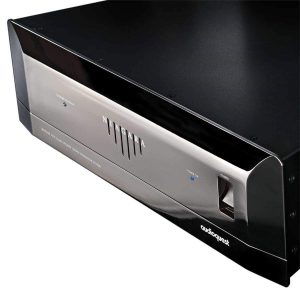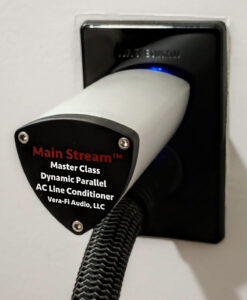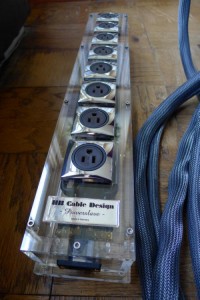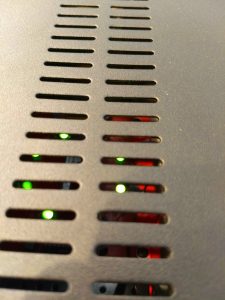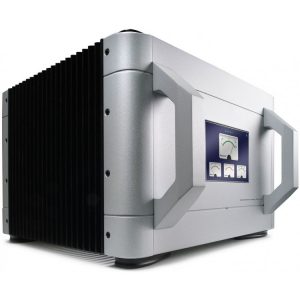.JPG)
One can wonder why so many people at certain age start using expression "I remember that..." more and more often. I can not not remember that several years ago whenever I came across such expression in a text it usually ignited at least some level of aversion towards obviously "advanced" age of its author. Why would anybody bring his memories/recollections all the time up, while what mattered was here and now?! I realized recently that more and more my own texts open today with something like: "I remember that...", but I also realized that using this expression was not about my age, but about experience gained over time, an experience that helped me to better understand many things.
So with a great pleasure and confidence I'd like to say that I remember very well the moment from several years ago (when I was working for Chorzów's "Sound & Vision"), when I saw an add of totally unknown company called Power Audio Laboratories. The design, both external and internal, of their devices was truly impressive, much nicer/better than most of other power filters/conditioners available on the audio market at the time. At this time PAL competed directly with key players on the market, some of which don't even exist anymore. In fact Power Audio Labs doesn't exist any more either. But in this particular case, luckily for us, one of PAL's founders, Adam Szubert, decided to continue the work on his own by founding another company, called GigaWatt. Some of you might not remember PAL, but GigaWatt is a renown brand name today.
Using pictures of the inside of PAL's products in commercial adds was no accident. It was quite unusual approach back then and it is still today. But PAL was not afraid to show the internal design of their products as build and fisnish quality was simply amazing. Still today it sets standards for other brands to follow. Maybe not for GigaWatt, as it took all the best ideas from PAL's products and basing on them created its own solutions and a characteristic looks of its devices. It is clear that Adam's (I use his first name not because of lack of respect but because we've known each other for years) products are to be treated as as important part of any audio system, as its other components. That is why it sports a solid, beautifully finished front panel with a display delivering information on current voltage, and a solid, rigid chassis with nice anti-vibration feet. All these elements suggest, what I agree with with all my heart, that this device's importance for the system equals importance of any other component like a source, or amplifier, and thus its price might also be comparable to that of other components. Back then, in 1998, when PAL started, such a philosophy would have been treated as "crazy talk", but today it is almost an industry standard.
A few simple words…
ADAM SZUBERT - GigaWatt | Owner
One of the critical issues for our company at the moment is our big investment that is about to be finalized—our new headquarters including also our workshop space. It should be ready beginning March. You can see its final appearance on the picture below. It's a newly constructed building with 230 sqm surface that includes a reception, office space, conference room, a warehouse, assembly room, kitchen, bathroom, and most importantly 40 sqm listening room (stereo and THX), that was designed by a Lodz based company Audile (Krzysztof Pajor).
We delivered for this test the latest version of our PC-4 EVO power conditioner, that includes a new feature—DCB Offset Blocker—a circuit that eliminates unwanted DC elements also (unfortunately) delivered by power grid. This device is capable of a lossless transfer of energy and it will withstands even large loads. It is an important statement as many of our clients heard about some cheap power strips with DCB circuits that went up in flames as they couldn't withstand the load. It's not the case here! Apart from additional protection our conditioner with DCB ensures, it (or a system with it) also simply sounds better. DCB is now offered as an option for all EVO conditioners, at additional cost, of course.
Another new (introduced last year) product in our portfolio is our flagship power cable – LS-2. It is very successful on many foreign markets. Its development took particularly long time before we finally decided that it was ready for production, but the product itself and coherent opinions coming from our distributors and clients proved beyond any doubt that all that time and effort did not go to waste. It was a great decision to fine-tune LS-2 until we were absolutely happy with its performance.
Another novelty in our offer is a circuit breaker that is manufactured for us by Carling. It complements our "installation offer", that already included in-wall LC-Y cable. And the latter is also considered by many almost a "cult" product today. Krzysztof Pajor, who designed from grounds up our new listening room, installed once our LC-Y cable for quite wealthy customer, who had few separate power systems, some based on LC-Y and some on top Furukawa cable. Imagine Krzysztof's surprise when, after the comparison between these two cables, customer informed him that in his opinion Furukawa performed "slightly better". To realize what that means one has to know the price of Furukawa cable, that is roughly 10 times more expensive than our LC-Y!
For mid-February we anticipate a release of new budget power strip, PF-1e. It will be available in two versions—with and without power cable. When designing it we tried to achieve as similar performance to a "regular" PF-1 as possible. It was a difficult task, and obviously there would be some differences in performance. But we think we did our job really well! We managed to lower costs by using some alternative, less expensive components, and the version without power cable will cost only 250 EUR. This product is a proof that it is possible to make a good product for people on the budget, although we, as manufacturer, won't make much money of it. It is in fact sort of a gesture towards our clients who can't spend that much on power accessories.
SOUND
Recordings used during test (a selection)
• Art Blakey Quartet, A Jazz Message, Impulse!/Universal Music Company (Japan) UCCI-9043, "Best50", No. 43", CD (1963/2001).
• Bemibem, Bemowe Frazy, Polskie Nagrania MUZA/Polskie Nagrania PNCD 1096, "Polish Jazz DeLuxe", CD (1974/2007).
• Chet Baker & Art Pepper, The Route, Pacific Jazz/Capitol/Capitol-EMI Music CDP 7 92931 2, CD (1989).
• Jim Hall Trio, Blues On The Rocks, Gambit Records 69207, CD (2005).
• Karl Bartos, Off The Record, Bureau CD 974282 BB079, CD (2013).
• Laurie Anderson, Homeland, Nonesuch 524055-2, CD + DVD (2010); review HERE.
• Leonard Cohen, Popular Problems, Sony Music Labels SICP-4329, CD (2014); review HERE.
• Miles Davis, The Original Mono Recordings, Columbia Records/Sony Music Japan SICP 30521-9, Blu Spec CD2 x 9 (1957-1964/2013).
Listening session with particular product, comparisons between two or more of them, deliver almost all information necessary to describe them and to assess them. Using also knowledge about their design, engineering, used solutions, considering also manufacturer's reputation (this is an important element of product's value!) one is able to precisely assess what kind, if any, of changes it introduces to the sound. In audio system every element contributes to the performance, each of them "distorts" the original sound. Some devices do a better, and some a worse job, and every user for himself has to choose those that fulfill his expectations in the best possible way.
.JPG)
The moment of truth comes when a user is faced with a decision and needs to answer himself a question: do I want to spend next (whatever number) years with this amplifier, these speakers, accessories, and so on. Do they offer what I need to enjoy my music every day. For me personally, times when I wanted to have every second device I listened to, are long gone. Surely I still feel excitement when unpacking a new device, when turning it on for the first time, when listening to the music using them—I am a fan of audio, an audiophile after all. But it happens less and less often that I want to keep a reviewed product in my system. Yes, there are still some power amplifiers, digital an analogue sources I would love to replace my present ones with, but when it comes to my power system I am happy with what I have now.
So on one hand when reviewing numerous products made by GigaWatt, I always admired Adam Szubert's work—he created world class products that were a perfect match for many advanced audio systems. On the other hand Acoustic Revive RTP-4eu Ultimate and Acrolink Mexcel 7N-PC9500 power cables did such a fantastic job in my system fulfilling exactly my expectations, that I didn't feel this need to change them for something else.
.JPG)
New flagship products of GigaWatt managed to change that. It's not about me getting immediately rid of Japanese strip and cables and looking for a space in my room for PC-4 EVO. But for the first time I heard something that appeared to be a new reference (in the power area) which showed me exactly what Acoustic Revive and Acrolinks did with the sound of my system. Before this test everything they did was, from my point of view, unambiguously positive. But this is what progress in audio is about – anything that is the best at the moment won't be anymore when another, even better (or at the same level but different) thing comes along.
I am going to mention also these elements that were not unambiguously better. But I'm going to start with things that this Polish device does very well, although it might be the case, where it offered something else rather than something better than my Japanese system. I'd like to start with these features offered by PC-4 EVO with LS-2 that will make high quality systems sound spectacular.
Let me start with "few simple words", so to say. GigaWatt's system delivers higher dynamics than the Japanese one. Sound seems even more open with it. The proportions between mid-bass and the rest of the range are more accurate. A differentiation of the soundstage is better, and so are both range extremes. I also think that Gigawatt took a selectivity of my system at least one level up.
.JPG)
The biggest disadvantages of power conditioners is some limitation to dynamics they introduce for power amplifiers connected to them. Soulution 710 is particularly sensitive in that area as it is a particularly dynamic amp. Any change to its dynamics is always clearly audible. To my surprise there was no sign of any limitation with GigaWatt. What's more, I was under impression that this power conditioner even further improved my amplifier's dynamics.
The Polish conditioner defines more precise images thus allowing listener to look deeper into the soundstage. On one hand everything that is happening in the front of the stage seems closer than usually, on the other listener can "see" deeper into the soundstage. It's like the space between the front and the back of the stage became clearer, more transparent and that's what allows to look deeper. With my AR I don't really miss that perspective, even now when GW showed me that it might be even better. It's not that something I believed for some time was very good suddenly turned out to be not good. When that happens it means that previous system wasn't really that good as I thought it was. On the other hand these element introduced by GigaWatt were something new for me, but also something I truly liked.
"EVO" proved to me that AR strip slightly "thickens" sound. Not by much, and in the right area (lower midrange) but still. Images seemed richer, more subtle, but also "thicker". It's not about artificially enlarged sounds, after all also AR strip is one of the top solutions, but about small adjustments to make recordings sound "nicer". Sound with AR is amazingly resolving, and differentiation is fantastic, too. But at the same time it has this tendency to make sound more likable, nicer to listen to. It's like this Japanese power system and my Harbeth M40.1 speakers became best friends, who do each other some small favors. GigaWatt on the other hand put itself in the position of authority, a friendly one but less willing to compromise to "help" a friend. Its priority is what comes out of speakers, what happens between them rather than doing any favors to other system components.
.JPG)
I am not sure whether such an elaborate description anthropomorphizing this metal box is the right thing to do here, but on the other hand sometimes such comparisons and metaphors are in fact the best way to convey certain information.
Power conditioners often introduce also unwanted elements to the sound—systems connected to conditioners tend to sound "dry", with bass loosing some "weight". Polish device does not have this kind of influence on the sound. The Synergistic Research Tesla power conditioners and cables (seeHERE) offered yet something else—they enriched the sound, made it spectacular, but at the cost of clarity and transparency. Also ISOL-8 conditioners, fantastic devices, absolutely amazing ones, tend to sweeten presentation, just like my own power system does.
GigaWatt delivers a full range performance so even the lowest notes on Laurie Anderson's *Homeland in *Falling piece were accurately defined, had proper "weight' and energy. They were not as "warm" as with Acoustic Revive—obviously these sound features couldn't really be combined. But the differentiation (also in space) of these lowest notes was now better. I also thought that the lowest part of the bass range was clearer, more transparent and that initiated an impression of even better extension. It was just an impression but the whole perception of music is based on impressions, right?
Summary
GigaWatt's system modifies sound of the system to the lesser extend than any other power system I had a chance to check out in my room. But, to be honest, it was also the most expensive one. In top-high-end price is almost irrelevant, or at least much less important than in budget or mid-priced systems. What matters is how a particular product "sounds like". Let me remind you that "sounds like" translates into what kind and what level of distortion it introduces to the audio signal, how it modifies this signal. Anyway—that's the best power system I assessed in my system ever. Listening to the music with GigaWatt in the system I couldn't find any of downsides usually associated with this type of device.
With some reluctance I have to admit that the way my Japanese reference power system presents phantom images, due to richer midrange is what I truly like about it. Now I realize that it adds something from itself in this aspect making it less "honest", less "true than Gigawatt. But still this type of presentation truly appeals to my sensitivity.
To be perfectly honest I have to admit that Polish system delivers more true performance, without adding anything from itself. With it sound isn't "dry", is rich enough, and is better differentiated. Soundstage gains some depth and is more selective. In a perfect world it would offer a bit sweeter sound. But what would be Adam Szubert's job then?
.JPG)
GigaWatt has been on the market relatively short time. It was founded only 8 years ago. As I already mentioned though, it emerged from its predecessor, Power Audio Laboratories, and together these two companies combine 17 years of experience. Their products almost from a day one really bothered competitors with their quality, and every coming year brought new products, new ideas and solutions. These products always looked good, the engineering was impressive and sound-wise they impressed even more.
GigaWatt is the first Polish company, and one of very few, that we decided to award with our GOLD Fingerprint. This is an award for aggregated achievements of this company with two current products: PC-4 EVO (DCB) power conditioner and LS-2 power cable representing a pinnacle of these achievements. It's a great pleasure for us to give this award, but a large responsible for the recipient. We strongly believe that this is not the end but still a beginning of (hopefully) very successful road ahead for GigaWatt.
DESIGN
PC-4 EVO
PC-4 EVO is the latest version of GigaWatt's flagship power conditioner. By conditioner I mean a device that filters power delivered from electric grid, and protects devices connected to it. The name doesn't really reflect that but it is actually a third version of this product, after PC-4, PC-4 EVO. In this particular case what we get is a passive conditioner with additional active circuit—from this version GigaWatt equips its flagship with additional filter—DCB Offset Blocker, that eliminates DC elements from current from power grid. We could call this version: PC-4 EVO DCB.
This conditioner is a large device, that looks a lot like a serious power amplifier. Its front panel is made of a thick aluminum slab. In the center there is a black acrylic plate that covers and alphanumeric display underneath, that delivers current voltage of power grid (an effective voltage). The unit we reviewed had a blue display, but standard version sports a red one. Blue or green display will cost you additional 45 EUR if you can't live without it. And by the way— I would love to be able to turn the display off, which is not possible in this version. Chassis was made from thick, curved, metal sheets. The device sports nice anti-vibration feet made of aluminum and rubber.
.JPG)
The back panel sports two rows of power outlets, grouped in fours: for digital sources, for analogue sources and preamplifiers and power amplifiers with a low current requirements, and finally the third group dedicated to power hungry power amplifiers. Each of these sections sports its own filters. The sockets—G-040 Schuko—are manufactured for GigaWatt, and thus a logo on them. The brass contacts of these outlets were silver-plated at the factory, without usage of intermediary metals. Later they underwent two processes, well known from renown Japanese products—cryogenic modification and demagnetizing process. Back panel sports also a selected, high quality hydraulic/magnetic circuit breaker (for all outlets) and a red LED that indicates incorrect polarity. There is also a power inlet—it's a top quality PowerConNAC3FC-HC from Neutrik, its high-current version with silver plated contacts.
As I already said the inside of this device is even more impressive, at least for anybody who deals with audio devices everyday. Each section is meticulously planned. Three high current filters are placed near rear panel, each assigned to particular outlets. In the front, under shielding, there are another filtering elements. Next to power inlet you can find an active DC blocking circuit. I saw similar solution in ISOL-8 conditioners. The former are Pi type filters with chokes in the middle and polypropylene capacitors on both sides. The elements are soldered to PCBs with copper paths that are much thicker than usually.
.JPG)
.JPG)
Individual stages are connected with massive power distribution bars made of polished, high purity, silver-plated cathodes copper slabs (Cu-FO). According to the manufacturer these are second generation bars, as the previous generation wasn't silver-plated. More details about this device, employed technologies and solutions one can find on manufacturer's web page HERE.
LS-2
LS-2 is the most expensive power cable in GigaWatt's portfolio. All its elements were made either in-house or by selected external suppliers to Gigawatt's specification. Cable is made up of nine stranded runs of conductors, Ø 1,5 mm2 each. Conductors are made of purest, oxygen free copper, that is polished and silver-plated. Teflon is used as a dielectric. Cables sports a copper shielding and layers of damping material. The outer layer is made of polyolefin (same material if often used by Oyaide). Even the sleeving is a part of electrical project.
.JPG)
Mid-length there is a metal cylinder. It houses a double, passive filter of nano-crystal alloys. Cylinder is made of high grade aluminum, and so are plugs covers. Plug's contacts are made of rhodium-plated brass. All metal elements (just as those of PC-4 EVO) undergo cryo treatment and demagnetization. This power cable is also available in high current version (LS-2HC), that is used to power up a conditioner.
Specifications (according to manufacturer)
Available socket types: EU (Shuko), US (Nema 5 – 20R), AU (AS/NZS 3112)
Line voltage: 220-240 VAC, 50 Hz or 110-120 VAC, 50/60 Hz
Maximum output power: 3650 W
Maximum current load: 16 A
Absorbed impulse current: 22 000 A
Dimensions: 440 x 160 x 400 mm
Weight: 20,5 kg
Price (at the time of the test):
PC-4 EVO (with LS-2HC) - 9150 EUR
LS-2 – 3150 EUR/1,5 m
P.A. Labs
ul. Marii Skłodowskiej-Curie 1
95-100 Zgierz | Poland
[email protected]
www.gigawatt.pl
MADE IN POLAND
Text and images by Wojciech Pacuła










